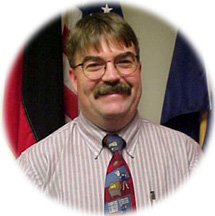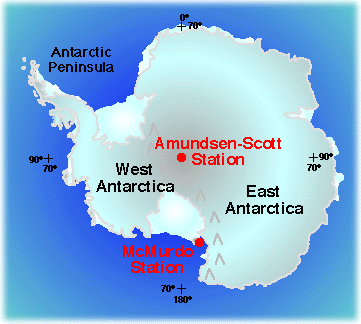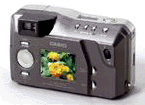
|
|






I was born and raised in California, moving up and down the state several times when my Father was
transferred between Lockheed Divisions. My Mother was a Travel Agent and professional Theater
Director during this time, so my family did a lot of traveling. The desire to see new and different
places was nurtured early in my life. When I was eleven I had the opportunity to tour Europe for
seven weeks with a theater group. I was hooked on the adventure of seeing new and different
places.
After high school I moved to Laramie, Wyoming where I attended the University of Wyoming,
earning a BS in Geology in 1984. Shortly after graduation I entered the Geology business working
for In-situ, Inc. working with groundwater monitoring products. My next geology position was in
Washington State working for Instrumentation Northwest, designing and installing monitoring pumps
and systems at various hazmat sites. While in this position I was approached about a drilling
program in The Sudan and I jumped at the chance to work in Africa. It was my experience in Africa
that turned me on to teaching. I was amazed at how a little education could vastly change the
lives of the people I worked with. I figured, if I can do this much to help people I can hardly
communicate with, I could make an even greater impact on kids who speak the same language as I do.
Boy was I naive! After returning to the US I enrolled in two programs at the University of
Wyoming. Secondary Science Education and Master of Science in Natural Science-Water Resources. To
put myself through school I worked as a state water commissioner, measuring water quality and
regulating agricultural water flow. This was a job that I truly loved, being able to be outside in
the grandeur of Wyoming on a daily basis. The fact that I had keys to all the best private fishing
holes didn't hurt either. Unfortunately this job like many others didn't provide the income needed
to support a family and so I had to move on to another line of work...equally challenging and
sometimes even more rewarding.
After graduation in 1990 I went into the classroom as a 7th and 8th
grade science teacher at Kauai High and Intermediate School in Lihue, Kauai. One year later I found
myself in Billings when my wife accepted a job in the area as a Speech Language Pathologist. I
have been teaching science since 1991 in Billings, first at the middle school and currently at
Billings Senior. I have taught all the subjects except Chemistry, (my minor in college!) I think
that my administrators are afraid that I might blow-up the school.
I have also been very involved
with the state science teachers association and currently am the president-elect. In 1996 I was
awarded a national Presidential Award for Secondary Science Teaching and in 1997 a Tandy Scholars
award. I also was awarded the MSTA Earth Science Teacher of the Year in 1996 and the MSTA Physics
Teacher of the Year in 1997. In 1998 I was very fortunate to spend 65 days on the NOAA Ship
Ka'Imimoana as a Teacher at Sea studying El Nino and diving in the Marshall Islands. You can follow
along on that adventure on a website provided by the State of Montana (www.metnet.state.mt.us).
Once you find the Metnet homepage look for NOAA's Ark and enjoy. I also have done many
presentations at State, Regional, National, and Global Science Conventions. In addition to my other
activities I am on several boards ( Science Expo and Conoco Citizen Advisory), do a weekly TV
Science Guy spot on the local CBS Station, Chair the Senior High Science Department, and co-teach
an Inquiry Class at the local University. I also have taken on an addition position in my district
with the mission to bring the middle schools up to safety code. With all my activities it is easy
to understand why my family thinks I am a type A personality. Speaking of my family, I am very
lucky to have a son entering the first grade next fall who, along with his classmates, will be able
to come on the adventure of a lifetime to Antarctica thanks to the magic of the Internet and the
good folks of the TEA Program.
Check out Richard's Web page at the Montana Office
of Public Instruction
http://ANT.metnet.state.mt.us/HTM/Antarctica.shtml

Longwave Radiations Processes over the Antarctic Plateau
Stephen G. Warren at University of Washington with Von P. Walden at University of Idaho
So what really is Longwave Radiation Processes over the Antarctic Plateau? I am going to try to give a “nutshell" description of what we are going to be doing at the South Pole. For the full meal deal, you can visit the research project website at http://www.atmos.washington.edu/~sgwgroup/
First there are several acronyms that I will try to define since I will be using acronyms for the equipment. The acronym also gives somewhat of a description of what the device is used for or what it measures.
FPH: Frost-point hygrometer, this is a device that can optically measure the frost point and thus the humidity. As frost forms on a reflective surface like a mirror it decreases the intensity of light source reaching a light meter. The device automatically raises and lowers the temperature of the mirror to pin-point the temperature at which the frost forms. This device will be both flown on the blimp and also used for surface measurements.
HYVIS: Hydrometeor Videosonde, this device actually will take video images of ice crystals as they fare captured on 35mm leader film. This device will be flown on the blimp and also used for surface measurements.
PAERI: Polar Atmospheric Emitted Radiance Interferometer, this device will be used to measure the spectrum of longewave (infrared) radiation that is downwelling from the atmosphere and upwelling from the surface. These data can be used to determine the spectral longwave climatology and the spectral cloud radiative forcing. The interferometer has the ability to measure the contribution of individual gases (H20, CO2, O3, and CH4/N2O) to the total downward flux.
SPT: South Pole Transmissometer, this device will transmit an infrared beam through a telescope out to an array of retroreflectors (mirrors). It is used to measure atmospheric transmission through a clear horizontal optical paths of up to 1 km; the retroreflector array is placed up to 0.5 km away from the SPT.
As a note of interest, both the PAERI and the SPT use the same Bomem interferometer. It only takes a few hours to change over the instrumentation, and I will be sure to include images of the transition in my journal.
Processes involving atmospheric longwave radiation, which occur worldwide in the upper troposphere and are important for global climate, can be studied at the surface of the Antarctic Plateau. Such studies offer some advantages over aircraft and laboratory experiments. A Fourier-transform interferometer, designed to measure atmospheric infrared emission with a spectral resolution of 1cm-1, will be modified to measure atmospheric transmission along horizontal paths over a spectral range 2-40 micrometers.
In addition to the above research the team plans to study spectral emissivity of snow and cloud radiative forcing, construct climatologies of spectral longwave radiation and cloud optical depths and parcticle sizes, compare atmospheric longwave emission to line-by-line calculations, and measure humidity in the boundary layer.
Fieldwork will be carried out at South Pole Station during the austral summer of 1999-2000 and a full year 2000-2001, expanding on an experiment carried out in 1992.
My deployment will be during the austral summer of 2000-2001, a small part
of the year long research.


Casio has provided a camera for Rick to use while he is in
Antarctica!

Movie:
360 Degrees At the South Pole

December 2000
November 2000
| Su |
Mo |
Tu |
We |
Th |
Fr |
Sa |
| -- |
-- |
-- |
1 |
2 |
3 |
4 |
| 5 |
6 |
7 |
8 |
9 |
10 |
11 |
| 12 |
13 |
14 |
15 |
16 |
17 |
18 |
| 19 |
20 |
21 |
22 |
23 |
24 |
25 |
| 26 |
27 |
28 |
29 |
30 |
-- |
-- |
October 2000
| Su |
Mo |
Tu |
We |
Th |
Fr |
Sa |
| 1 |
2 |
3 |
4 |
5 |
6 |
7 |
| 8 |
9 |
10 |
11 |
12 |
13 |
14 |
| 15 |
16 |
17 |
18 |
19 |
20 |
21 |
| 22 |
23 |
24 |
25 |
26 |
27 |
28 |
| 29 |
30 |
31 |
-- |
-- |
-- |
-- |
September 2000
| Su |
Mo |
Tu |
We |
Th |
Fr |
Sa |
| -- |
-- |
-- |
-- |
-- |
1 |
2 |
| 3 |
4 |
5 |
6 |
7 |
8 |
9 |
| 10 |
11 |
12 |
13 |
14 |
15 |
16 |
| 17 |
18 |
19 |
20 |
21 |
22 |
23 |
| 24 |
25 |
26 |
27 |
28 |
29 |
30 |
August 2000
| Su |
Mo |
Tu |
We |
Th |
Fr |
Sa |
| -- |
-- |
1 |
2 |
3 |
4 |
5 |
| 6 |
7 |
8 |
9 |
10 |
11 |
12 |
| 13 |
14 |
15 |
16 |
17 |
18 |
19 |
| 20 |
21 |
22 |
23 |
24 |
25 |
26 |
| 27 |
28 |
29 |
30 |
31 |
-- |
-- |
July 2000
| Su |
Mo |
Tu |
We |
Th |
Fr |
Sa |
| -- |
-- |
-- |
-- |
-- |
-- |
1 |
| 2 |
3 |
4 |
5 |
6 |
7 |
8 |
| 9 |
10 |
11 |
12 |
13 |
14 |
15 |
| 16 |
17 |
18 |
19 |
20 |
21 |
22 |
| 23 |
24 |
25 |
26 |
27 |
28 |
29 |
| 30 |
31 |
-- |
-- |
-- |
-- |
-- |
June 2000
| Su |
Mo |
Tu |
We |
Th |
Fr |
Sa |
| -- |
-- |
-- |
-- |
1 |
2 |
3 |
| 4 |
5 |
6 |
7 |
8 |
9 |
10 |
| 11 |
12 |
13 |
14 |
15 |
16 |
17 |
| 18 |
19 |
20 |
21 |
22 |
23 |
24 |
| 25 |
26 |
27 |
28 |
29 |
30 |
-- |
April 2000
| Su |
Mo |
Tu |
We |
Th |
Fr |
Sa |
| -- |
-- |
-- |
-- |
-- |
-- |
1 |
| 2 |
3 |
4 |
5 |
6 |
7 |
8 |
| 9 |
10 |
11 |
12 |
13 |
14 |
15 |
| 16 |
17 |
18 |
19 |
20 |
21 |
22 |
| 23 |
24 |
25 |
26 |
27 |
28 |
29 |
| 30 |
-- |
-- |
-- |
-- |
-- |
-- |
March 2000
| Su |
Mo |
Tu |
We |
Th |
Fr |
Sa |
| -- |
-- |
-- |
1 |
2 |
3 |
4 |
| 5 |
6 |
7 |
8 |
9 |
10 |
11 |
| 12 |
13 |
14 |
15 |
16 |
17 |
18 |
| 19 |
20 |
21 |
22 |
23 |
24 |
25 |
| 26 |
27 |
28 |
29 |
30 |
31 |
-- |
Return to top of page
|









